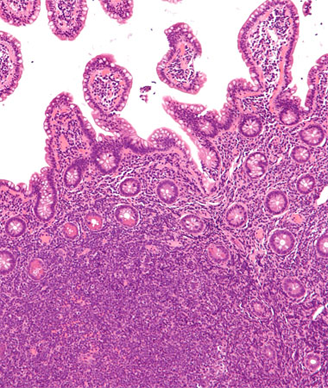Six Cycles of Fixed-Duration ViPOR Yields Positive Responses in MCL
A regimen consisting of venetoclax, ibrutinib, prednisone, obinutuzumab, and lenalidomide appears safe for a population of patients diagnosed with mantle cell lymphoma, as investigators report no significant dose-limiting toxicities or tumor lysis syndrome.
These findings were presented in a poster session at the 2023 Society of Hematologic Oncology (SOHO) Annual Meeting.

Treatment with fixed-duration venetoclax (Venclexta), ibrutinib (Imbruvica), prednisone, obinutuzumab (Gazyva), and lenalidomide (Revlimid; ViPOR) resulted in a high undetectable minimal residual disease (MRD) complete response (CR) rate in patients with mantle cell lymphoma (MCL), with benefit extending to blastoid, TP53-mutant, post–Bruton tyrosine kinase inhibitor, and refractory subgroups.
In a population of 22 patients, the CR rate was 100% following treatment with the ViPOR regimen; this population included 7 patients with blastoid, 6 with TP53-mutant, 5 with post-BTK inhibitor, and 8 with refractory disease.
Moreover, the 1-year time to progression (TTP) rate was 88.7% (95% CI, 61.4%-97.1%). Additionally, TTP rates in those with treatment-naïve and relapsed/refractory disease, respectively, were 90.0% (95% CI, 47.3%-98.5%) and 87.5% (95% CI, 38.7%-98.1%; P = 0.96). In those with blastoid vs non-blastoid histology and TP53-mutant vs unmutated disease, the 1-year TTP rates were 100% (95% CI, 100%-100%) vs 55.6% (95% CI, 7.3%-87.6%; P = .014), and 91.7% (95% CI, 53.9%-98.8%) vs 80.0% (95% CI, 20.4%-96.9%; P = .65), respectively.
To be eligible for the study, patients needed to have adequate organ function. Additionally, those in the relapsed/refractory population were required to have previously been treated with a previous rituximab (Rituxan)-containing regimen. Additionally, in phase 1 of the study, a 3+3 design was used to identify the maximum tolerated dose (MTD) for venetoclax—either 200 mg or 400 mg—in the relapsed/refractory cohort; ibrutinib, prednisone, obinutuzumab, and lenalidomide were administered at fixed doses.
Patients were treated with 1000 mg of obinutuzumab intravenously on days 1 and 2; 100 mg of oral prednisone once daily on days 1 to 7; 560 mg of oral ibrutinib once a day on days 1 to 14; 15 mg of oral lenalidomide daily on days 1 to 14; per dose escalation venetoclax on days 2 to 14; and 6 mg of pegfilgrastim subcutaneously on day 8 for 6 cycles.
The phase 2 dose expansion cohort included patients with both relapsed/refractory and treatment-naïve MCL at the MTD. Patients were treated with a maximum of 6 cycles of ViPOR with no maintenance or consolidation. Every patient was treated with Pneumocystis jirovecii pneumonia and granulocyte colony stimulating factor prophylaxis. Moreover, investigators collected plasma for circulating tumor DNA analysis at baseline, before each cycle, during every follow-up visit, and upon progression of disease; samples were assessed via next-generation sequencing of rearranged VDJ segments of Ig receptor genes.
The recommended phase 2 dose of venetoclax was 400 mg.
In the overall study population, the median age was 67 years (range, 41-82) and most patients were male (73%). Most patients had an intermediate-risk MIPI score (42%) and fell into the standard-risk MCL35 category (50%). Almost all patients had stage IV disease (96%), including bone marrow involvement (88%), extranodal involvement (88%), or both (81%).
Twenty-one of 22 patients were found to have calibrating rearrangements at a sensitivity of 1x10-6. The median time of non-detectable MRD was 6.0 months (range, 0-25) in those with CRs and no relapse.
Frequent any-grade hematologic adverse effects (AEs) included thrombocytopenia (63%), anemia (39%), and neutropenia (14%). Additionally, investigators reported incidences of grade 4 thrombocytopenia (3%) and neutropenia (3%). In terms of high-grade nonhematologic AEs, the most frequent grade 3 toxicities were hypokalemia (23%), rash (12%), fatigue (8%), atrial fibrillation (8%), and syncope (8%); there were no grade 4 nonhematologic toxicities.
Twenty-seven percent of patients required dose reduction; this included reductions for lenalidomide (87%) and venetoclax (11%). Reductions were necessary due to events of grade 4 thrombocytopenia (38%) and neutropenia (25%).
These findings were presented in a poster session at the 2023 Society of Hematologic Oncology (SOHO) Annual Meeting.
Reference
Lakhotia R, Pittaluga S, Phelan J, et al. Venetoclax, ibrutinib, prednisone, obinutuzumab, and lenalidomide (ViPOR) in relapsed/refractory (R/R) and treatment-naïve (TN) mantle cell lymphoma (MCL). 2023 Society of Hematologic Oncology (SOHO) Annual Meeting. September 6-9, 2023; Houston, TX; MCL-349.
Between the Lines Podcast: Tazemetostat in Relapsed/Refractory Follicular Lymphoma
November 3rd 2022Expert oncologist/hematologists Bruce Cheson, MD, FACP, and Steven Park, MD, discuss findings from the E7438-G000-101 trial and consider the efficacy of tazemetostat as treatment for relapsed or refractory follicular lymphoma.